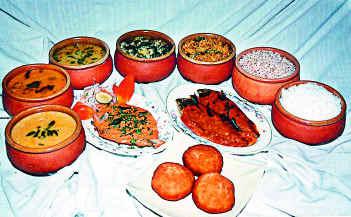Originating from the Konkan region, India’s ruggedly beautiful western coast, theSaraswat Brahmins are one of India’s oldest and most treasured communities. They proudly trace their ancestry back to the banks of the Sarasvati, an ancient, lostriver that featured frequently throughout the Rig Veda and later Vedic texts.
Like the Ganges, the Sarasvati River holdsa spiritual significance for the Hindus. The first part of the Rig Veda is said to have been created on the river’s banks and so reverence is given to it through innumerable hymns, songs and legends. These sacred texts have moulded India and become intertwined with all parts of her religion and culture.
Over time and history, branches of Saraswat Brahmins dispersed around the country, resulting in a cuisine as vast and variable as India herself. India has been blessed with bountiful and fertile soil, and so like many of her regions, Saraswat cuisine makes use of the array of fruits and vegetables naturally available to them.
The cuisine is largely pesco-vegetarian though some regions do follow a strict vegetarian diet. Ingredients such as tamarind, cashew nuts, curry leaves and coconut are commonly found in its curries and the majority of dishes are prepared using coconut oil. On some days, typically a Monday, Saraswat Brahmins must only eat vegetarian food.

One sub-sect of Saraswat Brahmins, the Satkiv Brahmins follow a strict vegetarian diet called ‘savalemranapp.’ Satkiv Brahmins, like Jains, will not eat plants or vegetables that are taken out of the ground, such as garlic, onions or potatoes. During religious holidays and festivals, this diet is adopted by people across India to pay homage to their history.
While many of the vegetarian dishes are mild, they are great to prepare at home. Why not trykarams (vegetable salads), tondak (beans and cashew nuts), ross (coconut based dishes),usal (spicy pulses cooked in a thin gravy),misal (usal topped with fried snacks), nonche (pickles) and papads (flatbreads).
Goan cuisine, another branch of Saraswat gastronomy, is perhaps the most seafood-centric. Access to the Arabian Sea provided an abundance of food, including the likes of mackerel, shark, tuna and shellfish such as mussels, prawns, lobsters and squid. If possible, try Goan’s famous fish curry, HoomananiXit.
Interestingly, while the cuisine features innumerable dishes with seafood, it is still deemed to be vegetarian. This is because according to folklore, when the Saraswat River dried up, the indigenous people there were unaware of how to farm and so the consumption of seafood was permitted to ensure their survival. It is due to this that oysters are still known today as ‘samudraphalam,’ or ‘sea fruit,’ echoing a time where fish were known as ‘sea-vegetables.’
Saraswat cuisine is one of India’s most flavoursome and delightful creations, catering perfectly for both pescatarians and vegetarians alike. If you would like to try any of these dishes but do not want to have to travel all the way to India, why not book a table at Amaya, one of London’s best fine-dining restaurants that offers both sizzling seafood and delicious vegetarian dishes.










Comments are closed.